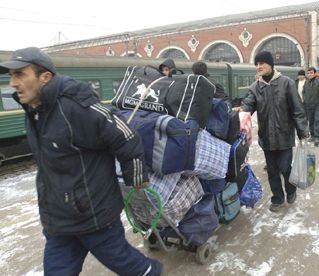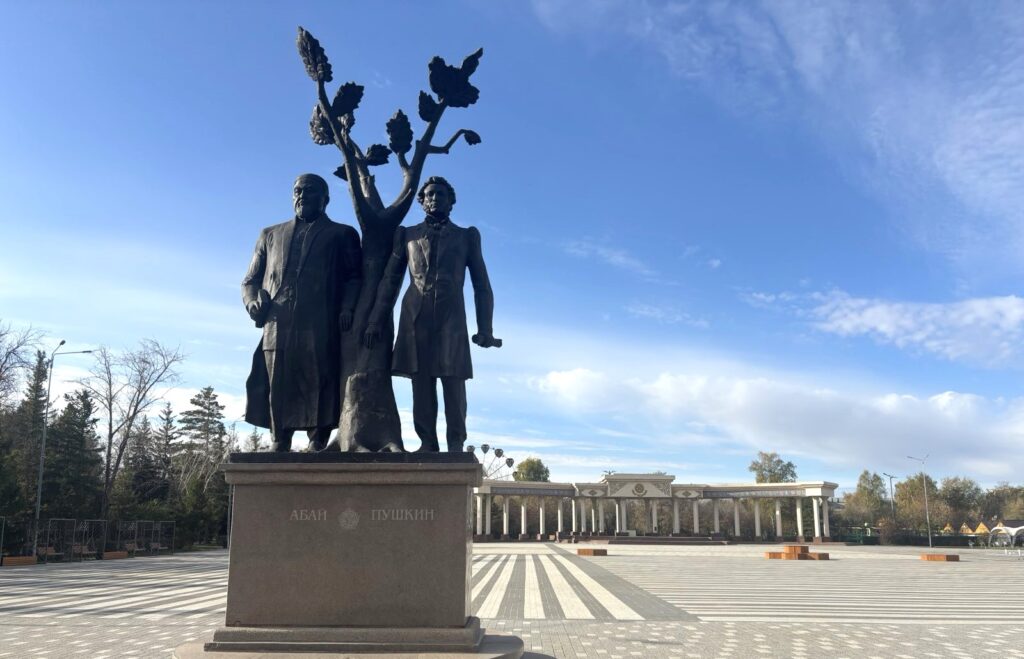BISHKEK (TCA) — Central Asian economies excluding Kazakhstan are heavily dependent on labor migrant transfers. Migrants from Uzbekistan are leading in terms of remittances. In 2018, of $9.5 billion transferred by individuals from Russia, the most money was sent to Uzbekistan.
Uzbekistan ranks first
According to the Central Bank of Uzbekistan, individuals transferred $5.1 billion to the country in 2018. As before, Russia ranks first (almost $4 billion) followed by Kazakhstan ($320 million), Turkey ($204 million) and the United States ($188 million).
With a population of almost 33 million, Uzbekistan is not only the most populous but also the most migrant-sending in the region. According to official data, about 20% of Uzbekistan’s working-age population permanently works abroad and 85% of them in Russia.
However, Russia is becoming less attractive for migrants due to the depreciation of the ruble against the dollar, high cost of labor patents and the need to pay a percentage of salary each month in favor of the budgets of host regions.
Recently, Uzbekistan was a closed country, and it was almost impossible for the media to obtain data on the country’s economy. The situation changed after Shavkat Mirziyoyev came to power in 2016, and Uzbekistan’s Central Bank began to publish previously classified data.
The current authorities recognize the significant contribution of labor migrants to the country’s economy, while under President Karimov they were considered “parasites” disgracing Uzbekistan.
Remittances from migrants are 2.4-fold more than the currency inflow from gas exports, 4.7-fold more than exports of textiles and 7-fold higher than agricultural exports, financial expert Shavkat Sharipov told Ferghana news agency.
Remittances to Uzbekistan could have been higher if not for the fall in the rates of national currencies. Over the past year, the Russian ruble fell against the US dollar by about 15%, Kazakhstan’s tenge — by 20%, and Turkish lira — by 28%.
Any currency fluctuations in these countries sensitively affected the labor migrants’ earnings, the economist added. Earlier, Uzbek citizens working in Russia regularly sent home an average of 25,000 rubles ($450), but this amount has now decreased to $380.
In Tajikistan, remittances help service country’s debt
According to the Russian Central Bank, remittances of individuals from Russia to Tajikistan amounted to $2.553 billion at the end of last year.
More than $224 million was spent for servicing the country’s external debt last year, Tajikistan’s Finance Ministry said. So, the monthly remittances of individuals, mainly labor migrants, from Russia to Tajikistan is almost equal to the annual amount the country spends to service its foreign debt, Avesta reported.
The total external debt of Tajikistan at the beginning of 2019 was $2.9 billion, 38.9% of GDP.
Remittances of individuals from Russia to Tajikistan were equal to 36% of the country’s GDP (over $7 billion) last year.
Labor migrants transfer money to Tajikistan not only from Russia, but also from other CIS countries and Europe. However, the National Bank of Tajikistan does not disclose data on remittances, the local media report. Earlier, the National Bank stated that it was impossible to determine the proportion of migrant workers’ transfers in the total flow of money into the country which also includes settlements of small entrepreneurs.
However, experts believe that at least 95% of the remittances from Russia to Tajikistan are precisely the migrants’ earnings.
Migration amnesty for Kyrgyzstan citizens
Russia has announced a migration amnesty for Kyrgyzstan citizens from March 29 to April 22, 2019. According to the Ministry of Foreign Affairs of Kyrgyzstan, 992 Kyrgyz citizens who are on the blacklist of the Federal Migration Service of Russia (FMS) can benefit from the amnesty. Citizens who have violated the terms of their stay in Russia are given the opportunity to legalize themselves without leaving Russia.
A total of 65 thousand Kyrgyzstan citizens are blacklisted by the Russian FMS.
Besides, 131 thousand of Kyrgyzstan citizens who are currently in Russia are under the amnesty as well. These are migrants who have overstayed in Russia or committed minor administrative violations. They also can now legalize their stay in Russia without leaving the country.
The migration amnesty does not apply to citizens who are not allowed to enter Russia due to court decisions on administrative expulsion from Russia.
According to the Migration Service of Kyrgyzstan, 710 thousand of Kyrgyzstan citizens are in labor migration abroad. Of these, 640 thousand are working in Russia, 30 thousand — in Turkey, 15 thousand — in South Korea, 30-35 thousand — in Kazakhstan, and the rest are in Europe, America, etc.
There are 110 private employment agencies in Kyrgyzstan which hire locals to work in Denmark, the Czech Republic, Poland and Japan. If a company abroad has an agreement with an employment agency, there will be no problems with obtaining a visa.
Every year, more Kyrgyz citizens leave for South Korea. According to the state employment program started in 2007, 250-300 local people are hired for employment in the Republic of Korea annually.
About six thousand Kyrgyzstanis are now working in Korea, Ambassador of the Republic of Korea to Kyrgyzstan Ha Tae Yok told Sputnik.kg. The flow of labor migrants is growing, mainly from the southern regions of Kyrgyzstan. First of all, they are attracted by salaries ($1.5-2 thousand per month), as well as very good working conditions, high rates for hourly work and a lot of bonuses, the Ambassador added.
Kyrgyzstanis most often work at factories and they have no right to find a job, for example, in agriculture or the service sector.
The employment program provides for a five-year period of work, and two or three flows of migrants have already returned to Kyrgyzstan. According to the Ambassador, the quota allocated by South Korea’s government is 500 jobs, but there are not enough suitable Kyrgyz people to meet the demand from employers.
According to a study conducted by the AUCA analytical center, shadow labor migration has increased by 11% in Kyrgyzstan over the past two years.
The survey involved 1,100 men and women of all ages working in Russia and Kazakhstan. The majority of Kyrgyz citizens who work officially are staying in Russia or Kazakhstan for five years or more. Many work on the basis of employment contracts in fairly large companies. Those who work for private traders are fewer, and some labor migrants opened their own businesses.
The most common employment areas are services and entertainment, trade, public catering, healthcare, transport and communications, as well as working in private households as nannies, nurses and housekeepers. Many men are engaged in the construction industry.
Turkmenistan lacks qualified specialists
Due to the growth of labor migration in Turkmenistan, there is a shortage of qualified specialists there, especially in healthcare and education.
In some regions, local authorities invite to work in schools and medical institutions retirees and those who have been released from prison even if they were forbidden to hold certain positions in accordance with court rulings. For example, a surgeon and a therapist who had previously been convicted of taking bribes from patients returned to their posts at the same hospital in a Turkmen village, Chronicles of Turkmenistan reported.
The local authorities are trying to solve the personnel shortage problem by merging small districts, after which some first-aid posts were closed and the remaining personnel was distributed among the others. At the same time, even with the most acute personnel shortage, managers continue to demand bribes from specialists to be hired, local media said.
Teachers and healthcare workers massively leave for Turkey, where they earn good money working as nurses for retirees and people with disabilities, or looking after children.
A migrant worker in Turkey told that working as a teacher in a secondary school in Turkmenistan she earned about 2,000 manats a month while she now has a decent salary 3-4-fold more than at home working as a nurse with a disabled person in Turkey. Besides, she does not have to pay for housing and food.
Turkey attracts Central Asia labor migrants
Turkey has become increasingly attractive for labor migrants from Central Asia, The Diplomat reported. Ankara established visa-free regimes in an effort to expand trade and the movement of people. According to The Diplomat, “the Turkish government put in place less restrictive regulations than the Russian government. For example, Central Asian labor migrants do not need to register with any agency for the duration of their legal stay in the country”.
Turkmenistan, Uzbekistan and Kyrgyzstan are among the top 10 countries whose citizens held work permits in Turkey, the Turkish Ministry of Interior said.
From November 2018, citizens of Kazakhstan, Uzbekistan and Tajikistan can stay in Turkey for 90 days without a visa instead of 30 days before.
According to the Turkish Foreign Ministry, as of November 2018, more than 30 thousand citizens of Uzbekistan were officially registered in the country, and only about two thousand worked legally, having received work visas.
Turkey’s decision to extend the period of visa-free stay for citizens of Turkic-speaking countries was aimed at strengthening ties with these countries, experts say.
Meanwhile, migrants arriving to work from Tajikistan or Uzbekistan often do not obtain a work visa and work illegally. Turkey makes a lot of relief in terms of issuing visas for citizens of Central Asian countries, and expects the same attitude from them.
According to the Ministry of Internal Affairs of Turkey, Turkmenistan and Uzbekistan are leading in the number of labor migrants from Central Asia countries.









